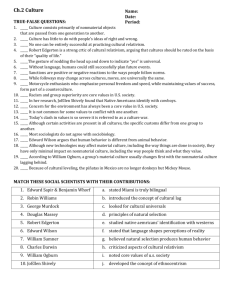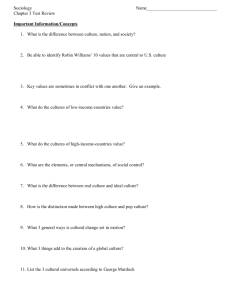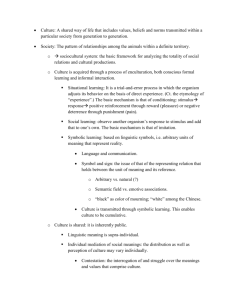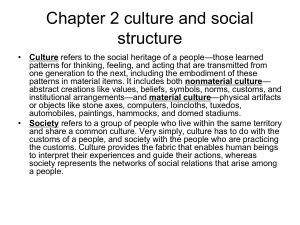henslin2
advertisement
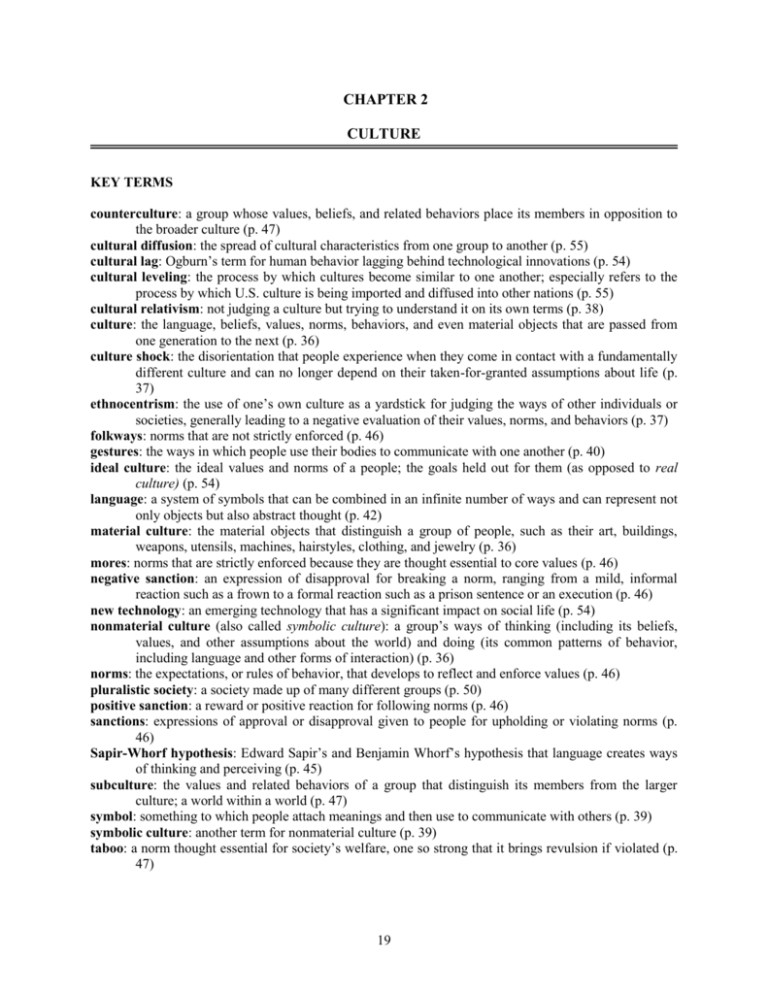
CHAPTER 2 CULTURE KEY TERMS counterculture: a group whose values, beliefs, and related behaviors place its members in opposition to the broader culture (p. 47) cultural diffusion: the spread of cultural characteristics from one group to another (p. 55) cultural lag: Ogburn’s term for human behavior lagging behind technological innovations (p. 54) cultural leveling: the process by which cultures become similar to one another; especially refers to the process by which U.S. culture is being imported and diffused into other nations (p. 55) cultural relativism: not judging a culture but trying to understand it on its own terms (p. 38) culture: the language, beliefs, values, norms, behaviors, and even material objects that are passed from one generation to the next (p. 36) culture shock: the disorientation that people experience when they come in contact with a fundamentally different culture and can no longer depend on their taken-for-granted assumptions about life (p. 37) ethnocentrism: the use of one’s own culture as a yardstick for judging the ways of other individuals or societies, generally leading to a negative evaluation of their values, norms, and behaviors (p. 37) folkways: norms that are not strictly enforced (p. 46) gestures: the ways in which people use their bodies to communicate with one another (p. 40) ideal culture: the ideal values and norms of a people; the goals held out for them (as opposed to real culture) (p. 54) language: a system of symbols that can be combined in an infinite number of ways and can represent not only objects but also abstract thought (p. 42) material culture: the material objects that distinguish a group of people, such as their art, buildings, weapons, utensils, machines, hairstyles, clothing, and jewelry (p. 36) mores: norms that are strictly enforced because they are thought essential to core values (p. 46) negative sanction: an expression of disapproval for breaking a norm, ranging from a mild, informal reaction such as a frown to a formal reaction such as a prison sentence or an execution (p. 46) new technology: an emerging technology that has a significant impact on social life (p. 54) nonmaterial culture (also called symbolic culture): a group’s ways of thinking (including its beliefs, values, and other assumptions about the world) and doing (its common patterns of behavior, including language and other forms of interaction) (p. 36) norms: the expectations, or rules of behavior, that develops to reflect and enforce values (p. 46) pluralistic society: a society made up of many different groups (p. 50) positive sanction: a reward or positive reaction for following norms (p. 46) sanctions: expressions of approval or disapproval given to people for upholding or violating norms (p. 46) Sapir-Whorf hypothesis: Edward Sapir’s and Benjamin Whorf’s hypothesis that language creates ways of thinking and perceiving (p. 45) subculture: the values and related behaviors of a group that distinguish its members from the larger culture; a world within a world (p. 47) symbol: something to which people attach meanings and then use to communicate with others (p. 39) symbolic culture: another term for nonmaterial culture (p. 39) taboo: a norm thought essential for society’s welfare, one so strong that it brings revulsion if violated (p. 47) 19 technology: in its narrow sense, tools; its broader sense includes the skills or procedures necessary to make and use those tools (p. 54) value cluster: a series of interrelated values that together form a larger whole (p. 52) value contradiction: values that contradict one another; to follow the one means to come into conflict with the other (p. 52) values: the standards by which people define what is desirable or undesirable, good or bad, beautiful or ugly (p. 46) KEY PEOPLE Robert Edgerton: Edgerton attacks the concept of cultural relativism, suggesting that because some cultures endanger their people’s health, happiness, or survival, there should be a scale to evaluate cultures on their quality of life. Douglas Massey: This sociologist has studied what happens in urban areas when immigration rates exceed the speed with which new residents can learn English and the proportion of non-English speakers increases. William Ogburn: Ogburn coined the term cultural lag. Edward Sapir and Benjamin Whorf: These anthropologists argued that language not only reflects thoughts and perceptions, but that it actually shapes the way a people perceive the world. JoEllen Shively: Shively researched the reasons why both Anglo and Native American moviegoers identify more with the cowboys than the Indians. William Sumner: Sumner developed the concept of ethnocentrism. Robin Williams: He identified twelve core values in United States society. 20 Chapter 2 Culture PRACTICE TEST 1. Which of the following characteristics are indicative of culture? a. The language spoken by a people. c. The values and norms of a people. b. The beliefs of a people. d. All of the above 2. Things such as jewelry, art, hairstyle, and clothing are referred to as: a. material culture. c. cognitive culture. b. nonmaterial culture. d. technological culture. 3. A group’s way of thinking and its’ common patterns of behavior are referred to as: a. material culture c. cognitive culture b. nonmaterial culture d. technology 4. To develop a sociological perspective, it is essential to understand: a. how culture affects lives. b. language. c. symbols. d. interpretation. 5. The disorientation experienced by being in a situation where one’s sense of nonmaterial culture is insufficient to understand a specific situation is referred to as: a. culture shock. c. ethnocentrism. b. cultural relativism. d. cultural lag. 6. The tendency to use one’s own group’s ways of doing things as the yardstick for judging others is known as: a. ethnocentrism. c. relativist fallacy. b. cultural relativism. d. cultural shock. 7. Which of the following refers to understanding a culture in its own terms? a. ethnocentrism c. material culture b. cultural relativism d. nonmaterial culture 8. A system of symbols that can be strung together in an infinite number of ways for the purpose of communicating abstract thought defines: a. symbols. b. sanctions. c. language. d. emotions. 9. ___________ are considered useful shorthand ways to convey messages without using words. a. Norms b. Folkways c. Gestures d. Mores 10. Written gestures for expressing yourself online are commonly known as: a. symbols. c. icons. b. emoticons. d. technology. 11. The concept that language determines consciousness and shapes one’s perception of objects and events is the: a. Korsikoff Syndrome. c. Malthus Theorem. b. Thomas Theorem. d. Sapir-Whorf Hypothesis. 21 12. Which of these has embedded within it ways of looking at the world? a. values b. beliefs c. language d. folkways 13. Which of these terms describe ideas of what is desirable in life? a. values b. construct c. sanction d. variable 14. A taboo refers to a norm so strongly ingrained that even the thought of its violation is greeted with: a. contempt. c. excitement. b. revulsion. d. encouragement. 15. A ___________ describes a world within the larger world of the dominant culture. a. subculture c. total culture b. cultural universal d. counterculture 16. U.S. society contains how many subcultures? a. hundred b. thousands c. tens of thousands d. millions 17. A counterculture is: a. a group which has its own values and norms but identifies with the main culture. b. a group which has values in opposition to the dominant culture. c. any subunit of the main culture. d. a group with the same values as the dominant culture. 18. Which of the following best describes US society? a. It is a individualistic society. b. It is a multidimensional society. c. It is a pluralistic society. d. None of these choices. 19. Sociologists use the term ______________ to refer to the values and norms that the group actually follows. a. real culture c. ideal culture . b. cultural universal d. high culture 20. The term _____________________ refers to an emerging technology that has a significant impact on social life. a. new technology c. global technology b. value cluster d. core values 21. The distinguishing factor between technology and new technology is that: a. technology is developed by less advanced cultures than new technology. b. technology fails to change nonmaterial culture whereas new technology does. c. new technologies have a greater impact on social life than technology. d. there is no difference in technology and new technology other than the name. 22. Who coined the term cultural lag? a. William Ogburn b. Max Weber c. d. 22 Talcott Parsons August Comte Chapter 2 Culture 23. In the process of ____________, groups are most open to change in their technology or material culture. a. cultural diffusion c. cultural hindrance b. cultural leveling d. cultural lag 24. The direction of cultural diffusion today is primarily from the ________ to other parts of the world. a. East c. North b. West d. South 25. Mexican piñatas often depict Mickey Mouse or Fred Flintstone. This is an example of: a. symbolic culture. c. cultural leveling. b. cultural lag. d. cultural relativism. 23 PRACTICE TEST — ANSWER KEY 1. D (page 36) 2. A (page 36) 3. B (page 36) 4. A (page 37) 5. A (page 37) 6. A (page 37) 7. B (page 38) 8. C (page 42) 9. C (page 40) 10. B (page 43) 11. D (page 45) 12. C (page 45) 13. A (page 46) 14. B (page 47) 15. A (page 47) 16. C (page 47) 17. B (page 47) 18. C (page 50) 24 19. A (page 54) 20. A (page 54) 21. C (page 54) 22. A (page 54) 23. A (page 55) 24. B (page 55) 25. C (page 55)

